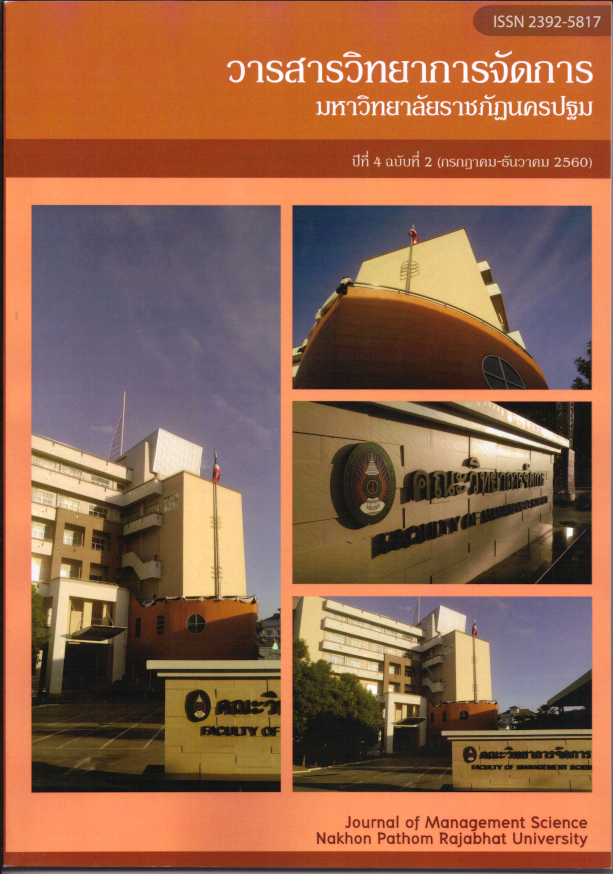The Strategies for developing Ecotourism Attractions in Samut Songkhram province.
Main Article Content
Abstract
The purposes of this research were to study the strategies for developing ecotourism attractions in Samut Songkram province, to study problems and barriers affecting the strategies, and to suggest the guidelines to make adjustments of the strategies. The qualitative methodologies used in this study were In-depth interview and documentary research. The structured and participatory observation interviews were conducted with three exampling groups comprising of local administrative organization officers, tourism and services entrepreneurs, hotel and resort entrepreneurs with a sum of sixteen selective sampling. In this research data had been analyzing simultaneously while being collected in order to validate the consistency of the content. The research findings were;
1. The strategies for developing ecotourism attractions in Samut Songkhram province were to stick to the developing plan aiming to develop Samut Songkhram provine attractions to be a center of leisure and ecotourism which identical with local culture and environments. Furthermore, other essential strategies regarding effective tourism management were needed to educate, to satisfy the tourists and to add values in ecotourism while conservations and maintenances of the attractions were regularly observed.
2. Problems and barriers of the strategies for developing ecotourism attractions in Samut Songkhram province were inadequate and improper usage of infrastructures and public utilities such as tourist attractions signs, sidewalk management, cleanliness of locations, historical tourist information boards. In additions, provincial private and public sectors did not take the major roles in promoting the tourism attractions, consistently providing tourists interesting information, creating new and innovative tourist activities, providing easy and convenient accesses to tourist locations, and always maintaining the locations in good conditions.
3. This research suggested that to develop the ecotourism attractions in Samut Songkram province successfully and sustainably, public and private sectors should collaborate closely, take a major roles in promoting the tourist attractions in the province especially those of which still unknown to tourist which most of them were unique and remarkable, for instance; ethic cultural Thai Song Dam village, Ban Hai Pun Bai and Ban Khao Yee San museums, Bang Noi and Bang Non Kwak floating markets, salt fields, Bang Plub agricultural village, and etc. In addition, tourist attractions should be conserved and always maintained in good conditions.
Article history : Accepted 29 July 2016
SIMILARITY INDEX = 5.85
Article Details
The views and opinions of the article appearing in this journal are those of the author. It is not considered a view and responsibility of the editorial staff.
References
การท่องเที่ยวแห่งประเทศไทย.[ออน-ไลน์]. (2549).แหล่งที่มาhttps://www.fisheries.go.th.
การท่องเที่ยวชุมชน. [ออน-ไลน์]. (2549). แหล่งที่มา https://www.communitytourism.net/ aboutusl.php.
โกวิทย์ พวงงาม. (2545). การเสริมสร้างความเข้มแข็งของชุมชน. ม.ป.ท.
บุญเลิศ จิตตั้งวัฒนา. (2548).การพั ฒนาการท่องเที่ยวแบบยั่งยืน. กรุงเทพฯ : เพรส แอนด์ ดี ไซน์.
สมหมาย ชินนาค และคณะ. (2550). การศึกษาแหล่งท่องเที่ยวในเขตลาวใต้เพื่อการเชื่อมโยงกับแหล่งท่องเที่ยวเชิงพื้นที่ในเขตอีสานใต้. รายงานการวิจัย. มหาวิทยาลัยอุบลราชธานี.
สำเนาว์ เสาวกูล และคณะ. (2550). บทบาทของผู้นำองค์กรการปกครองท้องถิ่นต่อยุทธศาสตร์การท่องเที่ยวในกลุ่มจังหวัดอีสานใต้. กรุงเทพฯ : สำนักงานกองทุนสนับสนุนการวิจัย.
สุรินทร์ และอุทยานแห่งชาติหมู่เกาะอ่างทอง. วิทยานิพนธ์ปริญญามหาบัณฑิต สาขารัฐประศาสนศาสตร์. สถาบันบัณฑิตพัฒนบริหารศาสตร์.
อาทิตย์ ศิริธร. (2541). วิสัยทัศน์การท่องเที่ยวของไทย ปีพุทธศักราช 2545. กรุงเทพฯ : วิทยาลัยป้องกันราชอาณาจักร.


